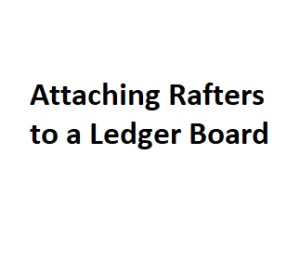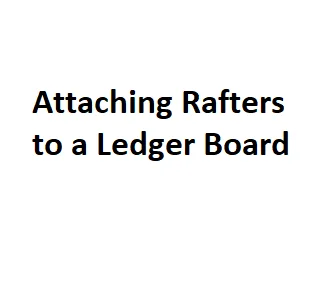Building a sturdy and reliable roof is crucial for the overall structural integrity of any home or structure. One key element in this process is properly attaching rafters to a ledger board. The ledger board serves as a critical connection point between the roof and the supporting structure, ensuring stability and durability. In this guide, we’ll walk you through the step-by-step process of attaching rafters to a ledger board, providing you with the knowledge and confidence to tackle this essential aspect of roof construction.
Steps to Follow:
Step 1: Gather Your Tools and Materials Before diving into the attachment process, it’s essential to gather all the necessary tools and materials. This typically includes a power drill, lag screws, washers, a level, a framing square, and of course, the ledger board and rafters. Make sure that your ledger board is made from a durable material such as pressure-treated wood to withstand weather exposure.
Step 2: Determine Rafter Spacing and Overhang Begin by determining the desired spacing between your rafters and the amount of overhang you want for your roof. These measurements will influence the placement of your ledger board and the attachment points for the rafters. Use a framing square and level to ensure accurate measurements and angles.
Step 3: Install the Ledger Board Secure the ledger board to the supporting structure using lag screws and washers. It’s crucial to make sure the ledger is level and properly aligned with your predetermined measurements. If the ledger is attached to a masonry wall, use appropriate anchors for a secure connection.
Step 4: Mark Rafter Positions on the Ledger With the ledger securely in place, mark the positions for each rafter along the length of the board. Use your framing square to ensure consistent spacing and alignment.
Step 5: Attach Hangers or Brackets To provide additional support for the rafters, attach hangers or brackets to the ledger board at each marked position. These will cradle the rafters securely, distributing the load evenly across the ledger.
Step 6: Install the Rafters Carefully lift each rafter into its designated hanger or bracket, ensuring a snug fit. Secure the rafters in place using appropriate screws or nails. Double-check the alignment and spacing to maintain the structural integrity of the roof.
Step 7: Bracing and Reinforcement Consider adding diagonal bracing or additional reinforcement as needed to enhance the stability of the roof structure. This step is especially important in areas prone to high winds or heavy snow loads.
Additional Tips for Success:
- Use Quality Materials: Invest in high-quality materials, especially when it comes to the ledger board. Pressure-treated wood is a common choice for ledgers as it provides resistance against decay and insects, ensuring the longevity of your roof structure.
- Follow Local Building Codes: Adherence to local building codes is paramount. These codes are in place to guarantee the safety and stability of structures. Check with your local building department to ensure that your design and construction methods comply with regulations.
- Consider Load-Bearing Capacity: Before attaching rafters, evaluate the load-bearing capacity of the ledger board and the supporting structure. This is particularly important if you plan on installing a heavy roofing material or live in an area with extreme weather conditions.
- Weatherproof Your Ledger: To protect the ledger board from the elements, consider applying a weatherproofing sealant or flashing. This will help prevent water infiltration and potential damage due to moisture.
- Ensure Proper Pitch: Confirm that your rafters are pitched correctly to allow for proper water runoff. A slight pitch ensures that water drains away from the roof efficiently, reducing the risk of leaks and water damage.
- Consult a Professional if Necessary: If you’re uncertain about any aspect of the process or if your project involves complex structural elements, it’s wise to consult with a structural engineer or a professional contractor. Their expertise can provide valuable insights and ensure the structural integrity of your roof.
- Inspect Regularly: After completing the installation, conduct regular inspections of your roof to identify and address any issues promptly. Early detection of problems can prevent more significant issues down the line.
- Safety First: Always prioritize safety during construction. Use appropriate safety gear, follow recommended safety procedures, and take precautions when working at heights. If the project requires it, consider hiring professionals for certain aspects of the construction process.
- Account for Roofing Material Weight: Different roofing materials have varying weights, and this can impact the load on your rafters and ledger. Be mindful of the chosen roofing material and factor its weight into your overall structural calculations to ensure that your roof can adequately support it.
- Optimize Rafter Size and Spacing: The size and spacing of your rafters depend on factors such as local building codes, the span of your roof, and the intended load. Consult engineering tables or a structural engineer to determine the optimal rafter size and spacing for your specific project.
- Use Blocking for Additional Support: Incorporate blocking between rafters to enhance lateral stability. This can be especially important in areas prone to high winds. Blocking helps distribute the load evenly and prevents individual rafters from twisting or sagging.
- Inspect and Seal Joints: Regularly inspect joints between the ledger board and rafters for signs of wear, movement, or water damage. Seal any gaps or cracks promptly to prevent water infiltration, which can weaken the structure over time.
- Employ a Collaborative Approach: If you’re working on a larger construction project, communication and collaboration among team members are essential. Ensure that everyone involved understands the design and construction plan to avoid errors or misalignments during the installation process.
- Consider Future Modifications: Anticipate potential future modifications or additions to your roof, such as solar panels or additional structures. Design your ledger board and rafter attachment points with flexibility in mind, allowing for easier modifications down the line.
- Document Your Process: Keep detailed records of your construction process, including measurements, materials used, and any adjustments made during installation. This documentation can be valuable for future reference, maintenance, or if you decide to make alterations or additions to your roof.
Rafter Attachment Methods
| Rafter Attachment Method | Description | Advantages | Disadvantages | Recommended Use |
|---|---|---|---|---|
| Lag Screws | Directly screwing rafters to the ledger board. | Strong connection. | Requires precise alignment. | Small to medium-sized structures. |
| Joist Hangers | Metal brackets that support rafters from the ledger. | Easy to install. | May rust over time. | Versatile for various structures. |
| LedgerLok Screws | Structural screws designed for ledger board attachment. | Fast installation. | Higher cost. | Suitable for deck construction. |
| Through-Bolts | Bolting rafters through the ledger with nuts and washers. | Extremely secure. | Labor-intensive installation. | Recommended for heavy loads. |
| Adjustable Brackets | Brackets allowing adjustment for rafter angle. | Flexibility in design. | Increased complexity. | Ideal for custom roof designs. |
Recommended Spacing for Rafters
| Roof Pitch | Rafter Spacing (inches) | Ledger Board Material | Roofing Material | Recommended Use |
|---|---|---|---|---|
| Low | 16-24 | Pressure-treated wood | Asphalt shingles | Residential roofs. |
| Moderate | 12-18 | Composite | Metal panels | Commercial roofs. |
| Steep | 8-12 | Cedar | Tile | High-pitched roofs. |
| Flat | N/A | Steel | EPDM | Flat roof structures. |
| Variable | Variable | Vinyl | Wood shakes | Custom roof designs. |
Ledger Board Attachment Hardware
| Hardware Type | Material | Size (inches) | Load Capacity | Recommended Use |
|---|---|---|---|---|
| Lag Screws | Stainless Steel | 1/4 x 4 | 500 lbs | Residential decks. |
| Carriage Bolts | Zinc-Plated | 1/2 x 6 | 1000 lbs | Commercial structures. |
| Hex Nuts | Galvanized | 5/16 | N/A | All ledger board attachments. |
| Washers | Stainless Steel | 1/2 | N/A | Enhanced load distribution. |
| Ledger Spacers | Plastic | Variable | N/A | Maintaining proper ventilation. |
Ledger Board Material Options
| Material | Description | Advantages | Disadvantages | Recommended Use |
|---|---|---|---|---|
| Pressure-Treated Wood | Treated to resist decay and insects. | Cost-effective. | May warp over time. | Residential decks. |
| Composite | Engineered wood product with durability. | Low maintenance. | Higher initial cost. | High-traffic areas. |
| Steel | Strong and durable material. | Resistant to rot and insects. | Prone to rust if not coated. | Industrial structures. |
| Aluminum | Lightweight and corrosion-resistant. | Low maintenance. | Limited load capacity. | Residential use. |
| Vinyl | Weather-resistant and low-maintenance. | Doesn’t rot or warp. | Limited structural strength. | Low-impact structures. |
Safety Precautions
| Safety Measure | Description |
|---|---|
| Fall Protection | Use safety harnesses or guardrails when working at heights. |
| Secure Footing | Ensure a stable and level working surface. |
| Personal Protective Equipment (PPE) | Wear appropriate gear, including gloves and safety glasses. |
| Tool Safety | Use tools correctly and follow manufacturer guidelines. |
| Inspections | Regularly inspect ledger board and attachment hardware for wear or damage. |
Remember, the successful attachment of rafters to a ledger board requires careful planning, attention to detail, and adherence to safety protocols. While this guide provides a comprehensive overview, always consult with professionals or local authorities if you have specific concerns or questions about your project. Building a robust and reliable roof is a rewarding endeavor that contributes to the long-term stability and safety of your home or structure.

